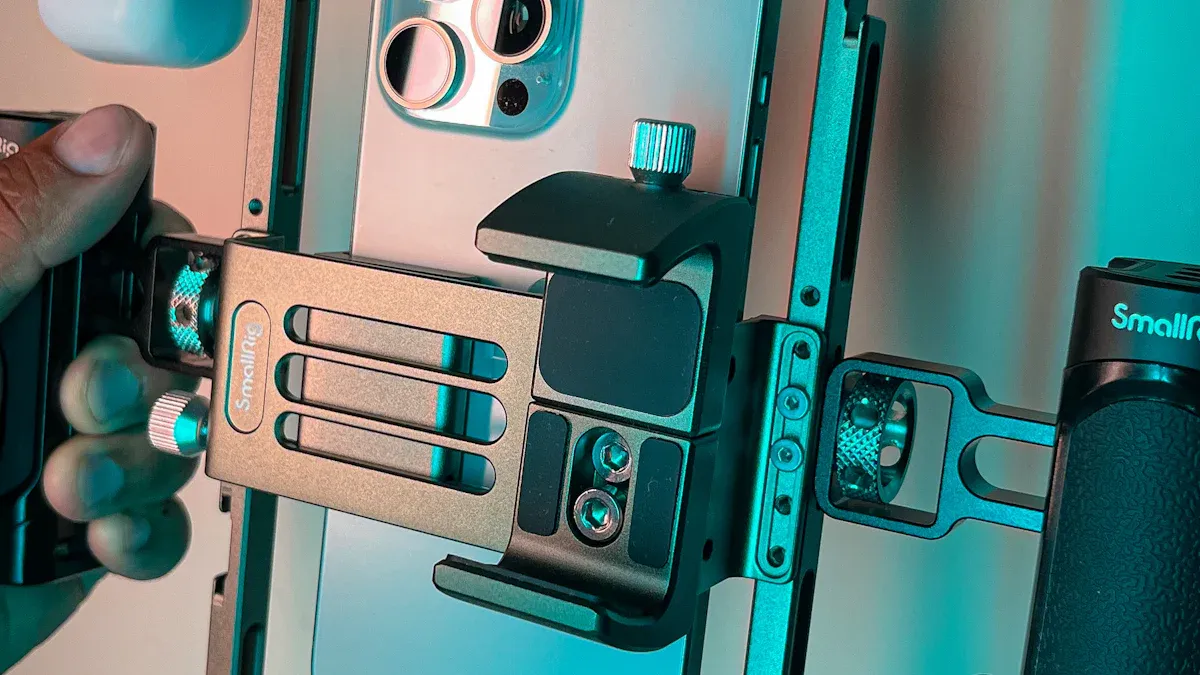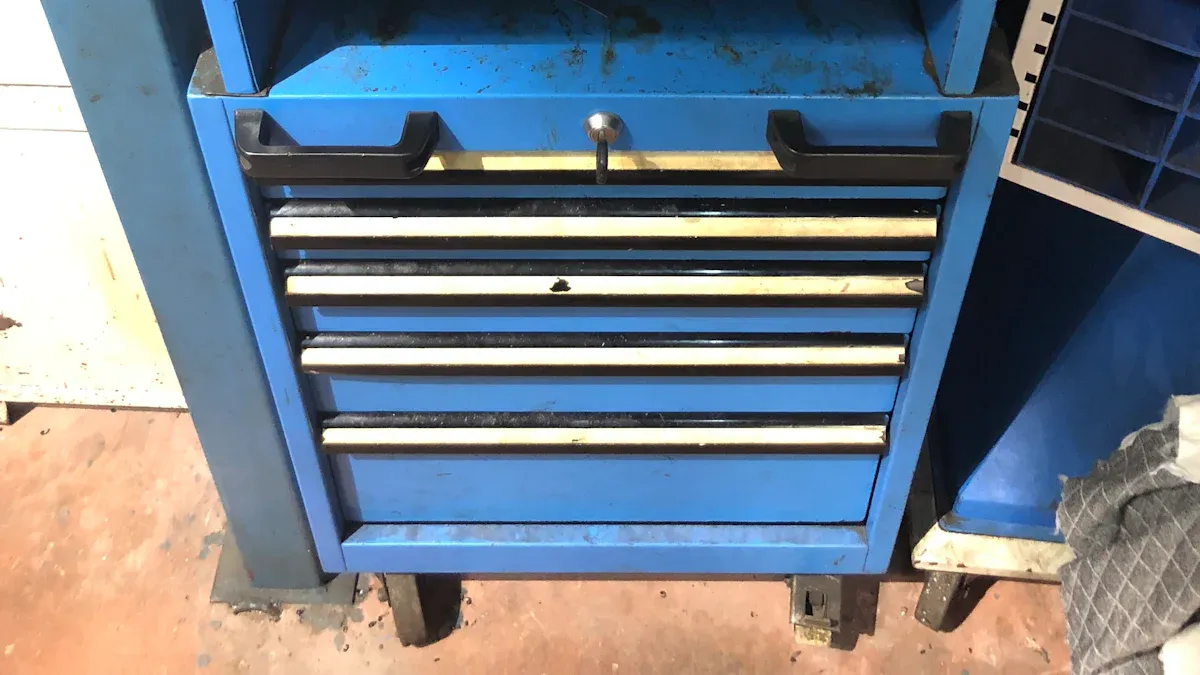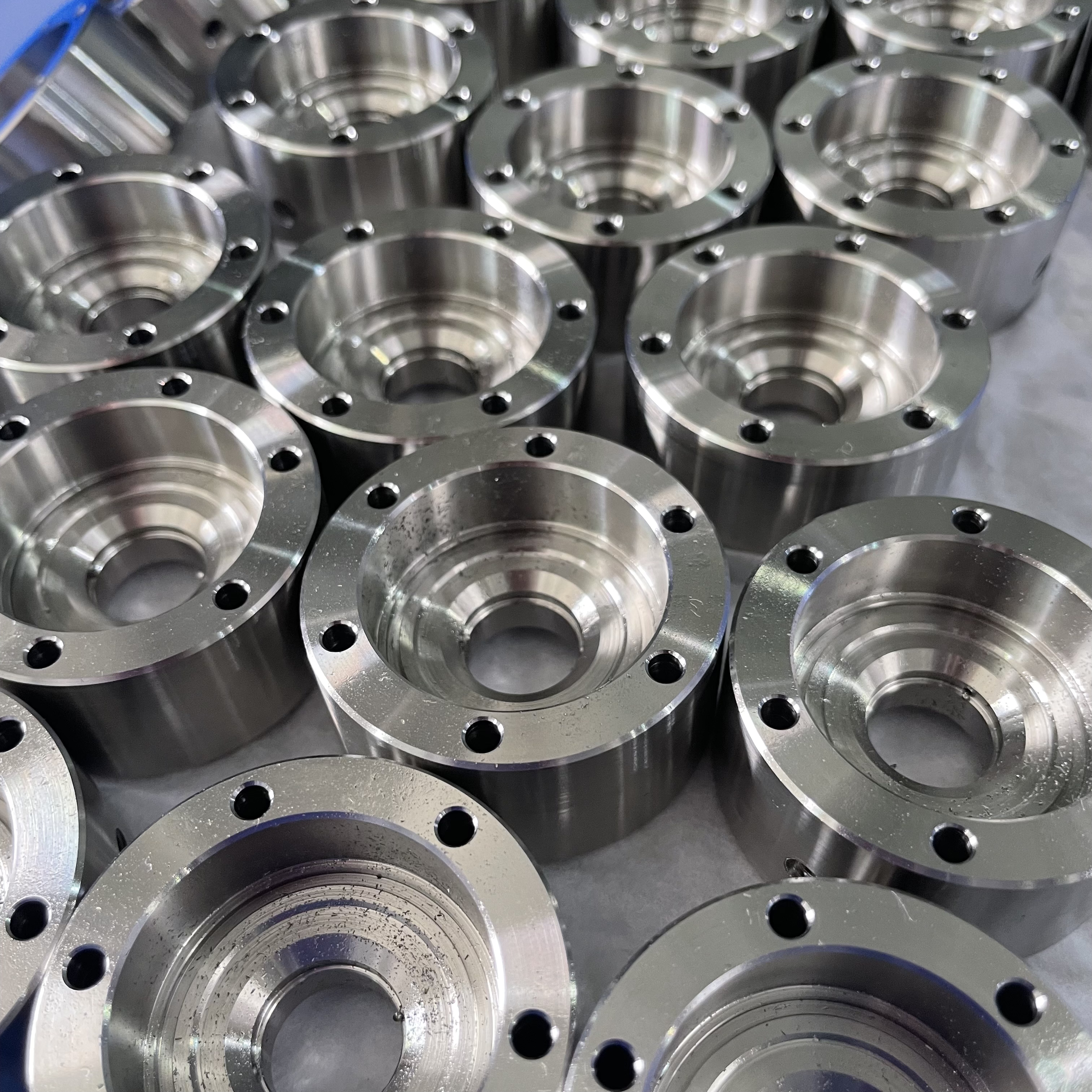Why Aluminum is a Top Choice for CNC Machined Robot Parts

When designing Custom Robot Parts, you need a material that balances strength and weight. Aluminum excels in this role. Its lightweight nature enhances mobility, while its high strength-to-weight ratio ensures durability. Aluminum’s machinability speeds up CNC production, reduces tooling wear, and delivers precise results. Its corrosion resistance also guarantees long-lasting performance in diverse environments.
Key Takeaways
Aluminum is light, helping robots move faster and more easily.
It is strong but not heavy, so it lasts longer in tough jobs.
Aluminum spreads heat well, stopping robots from getting too hot.
Aluminum’s Key Material Properties

Lightweight and High Strength-to-Weight Ratio
Aluminum’s high strength-to-weight ratio makes it a standout material for robotics. You’ll find it lighter than steel, yet it provides sufficient strength for demanding applications. For example, a block of aluminum measuring 2” x 2” x 8” weighs only 3.2 lbs, while the same size block of steel weighs over 9 lbs. This lightweight property allows robots to move quickly and efficiently, which is essential for tasks requiring agility. Aluminum alloys also enhance performance by offering durability without adding unnecessary weight. These characteristics make aluminum a preferred choice for CNC machined robot parts, especially in humanoid robots where safety and power efficiency are critical.
Corrosion Resistance for Long-Lasting Custom Robot Parts
Aluminum’s corrosion resistance ensures your robot parts last longer, even in challenging environments. Unlike steel, aluminum doesn’t rust. Instead, it forms a protective layer of aluminum oxide when exposed to moisture, which prevents further corrosion. This self-protecting property makes it ideal for robots operating in wet or humid conditions. Compared to other materials like copper alloys or steel, aluminum offers a balance of cost and corrosion resistance. While it costs more than steel, it provides better longevity without requiring additional protective coatings.
Thermal Conductivity for Heat Management
Efficient heat management is crucial for high-performance robots, and aluminum excels in this area. Its excellent thermal conductivity allows it to dissipate heat quickly, preventing overheating in critical components. This property is particularly beneficial for robots with high-power motors or electronic systems. By using aluminum, you can ensure your robot operates reliably under demanding conditions. Its ability to combine heat management with lightweight design makes it a versatile choice for CNC machining in robotics.
Machining Advantages of Aluminum
Ease of Machining for Complex CNC Machined Parts
Aluminum offers excellent machinability, making it ideal for creating complex CNC machined parts. You can achieve intricate designs with ease due to its low density and high malleability. This reduces tool wear and allows for faster cutting speeds compared to harder materials like steel. Advanced machining techniques further enhance aluminum's performance. For example:
High-Speed Machining (HSM) improves surface finish and reduces tool wear, especially for thin-walled parts.
5-Axis Machining enables the creation of complex geometries with fewer setups, ensuring high precision.
Ultrasonic Machining minimizes heat generation, making it suitable for brittle aluminum alloys.
These techniques ensure precision machining while maintaining the material's durability and high strength.
Cost-Effectiveness and Energy Efficiency
Aluminum is a cost-effective choice for CNC machining due to its excellent machinability. You’ll find that machining aluminum requires less energy than tougher materials like high-strength steel. Its low density allows for faster cutting speeds, reducing machining time and energy consumption. Additionally, aluminum’s malleability minimizes tool wear, lowering the frequency of tool replacements. These factors contribute to significant cost savings in both labor and machine operating hours. By choosing aluminum, you can achieve high performance while keeping costs under control.
Dimensional Stability for Precision Components
Dimensional stability is crucial for precision machining, and aluminum performs well in this regard. However, factors like thermal expansion, vibrations, and machine rigidity can affect stability during machining. Heat generated during the process may cause slight dimensional changes in the workpiece. To counter this, you should consider using machines with high rigidity to reduce vibrations and ensure consistent cuts. Aluminum’s properties, combined with proper machining techniques, allow you to produce precision components with reliable accuracy.
Popular Aluminum Alloys for CNC Machining
6061: Versatile and Reliable for Custom Robot Parts
6061 aluminum is one of the most versatile alloys you can use for custom robot parts. Its combination of strength, corrosion resistance, and machinability makes it a top choice for CNC machining. This alloy is particularly effective when treated to the T6 temper, which enhances its tensile strength to levels comparable to some 2000 series alloys. Additionally, its excellent forgeability allows you to create parts that can withstand structural loads and impacts.
Property | Description |
|---|---|
Excellent corrosion resistance | Forms a protective oxide layer, preventing rust and corrosion. |
High strength with T6 temper | Achieves impressive tensile strength after heat treatment. |
Good forgeability | Suitable for parts subjected to impact and structural stress. |
Machinability | Allows for efficient cutting and drilling, optimizing production time. |
6061 aluminum’s balance of properties ensures durability and reliability, making it ideal for robotics applications requiring lightweight yet strong components.
7075: High Strength for Demanding Robotics Applications
When your robotics project demands exceptional strength, 7075 aluminum is the alloy to choose. It offers a tensile strength of 572 MPa, rivaling certain types of steel. This makes it suitable for high-performance robots operating under extreme conditions. Despite its strength, 7075 remains lightweight, which is crucial for maintaining mobility in robotic designs. Its superior strength-to-weight ratio makes it a preferred material for aerospace and military applications, where durability and performance are critical.
2024: Excellent Fatigue Resistance for Dynamic Components
2024 aluminum is the go-to alloy for components subjected to dynamic stress. Its high strength-to-weight ratio and exceptional fatigue resistance make it ideal for parts that endure repetitive motion or strain. The addition of copper as a major alloying element enhances its ability to absorb stress over time, ensuring long-term durability. You’ll often find 2024 aluminum in aerospace applications, but it’s equally effective for CNC machined robot parts that require both strength and resilience.
Tip: Use 2024 aluminum for robotic components like joints or arms that experience constant movement. Its fatigue resistance ensures reliable performance over extended periods.
Aluminum’s Role in Robotics

Lightweight Design for Enhanced Mobility
Aluminum’s lightweight design plays a crucial role in enhancing the mobility of robots. Its density is about one-third that of steel, significantly reducing the weight of robotic components. This reduction allows robots to move, lift, and operate with greater agility. You’ll notice that lighter robots consume less energy, improving their overall efficiency. This makes aluminum an excellent choice for applications where speed and energy conservation are priorities. Whether you’re designing humanoid robots or industrial machines, aluminum’s lightweight nature ensures optimal performance without compromising durability.
Precision Compatibility for Complex Custom Robot Parts
Aluminum’s high strength-to-weight ratio ensures precision compatibility for complex custom robot parts. Its lightweight nature enhances the efficiency of robotic systems, especially those requiring quick movements. Aluminum alloys, such as the 5000 series, offer excellent machinability, making them ideal for high-precision machining. You can easily process aluminum through cutting, bending, and welding to create intricate components that meet tight tolerances. Techniques like die casting and CNC machining allow you to achieve micron-level precision, which is critical for moving parts in robots. This precision ensures that your custom robot parts function seamlessly in demanding applications.
Heat Management in High-Performance Robots
High-performance robots often generate significant heat, especially in motors and electronic systems. Aluminum’s excellent thermal conductivity helps dissipate this heat efficiently, preventing overheating. By using aluminum, you can ensure that your robot operates reliably under intense conditions. This property is particularly valuable in robots designed for industrial or high-speed tasks. Aluminum’s ability to combine heat management with a lightweight design makes it indispensable for creating high-performance custom robot parts.
Recyclability for Sustainable Robotics
Sustainability is becoming increasingly important in robotics, and aluminum stands out as a recyclable material. You can recycle aluminum without losing its original properties, making it an eco-friendly choice for custom robot parts. This recyclability reduces waste and minimizes the environmental impact of robotics projects. By choosing aluminum, you contribute to a more sustainable future while maintaining the performance and durability of your robots.
Real-World Applications of CNC Machined Aluminum Parts
Examples of Robots Using Aluminum Components
You’ll find aluminum components in many advanced robots due to their versatility and durability. Some notable examples include:
CNC Robotic Arms: These rely on aluminum for lightweight yet strong structures, enabling precise movements.
End Effectors: Aluminum’s machinability allows for the creation of intricate designs, ensuring reliable performance in gripping or manipulating objects.
Specialized Fixtures and Jigs: These components often use aluminum for its dimensional stability, which is critical for maintaining accuracy during operations.
Sensors and Controllers: Aluminum’s thermal conductivity helps dissipate heat, ensuring these sensitive parts function optimally.
These examples highlight how aluminum enhances the functionality and efficiency of robots across various applications.
Benefits of Aluminum in Robotics Projects
Aluminum offers several advantages that make it a top choice for custom robot parts.
Its lightweight design improves mobility and reduces energy consumption, making robots more efficient.
The high strength-to-weight ratio ensures durability, especially for frames and joints.
Aluminum’s precision compatibility allows for tight tolerances in complex designs, ensuring seamless operation.
Its thermal conductivity prevents overheating, which is essential for high-performance robots.
The material’s corrosion resistance reduces maintenance needs, even in harsh environments.
Finally, aluminum’s sustainability supports eco-friendly manufacturing, as it can be recycled without losing its properties.
By choosing aluminum, you can create CNC machined parts that combine strength, precision, and sustainability, ensuring your robots perform reliably in demanding conditions.
Aluminum continues to lead as the material of choice for CNC machined robot parts. Its lightweight design enhances mobility, while its high strength-to-weight ratio ensures durability. You’ll find it indispensable in modern robotics, where speed and precision are critical. As robotics technology advances, aluminum’s versatility will drive innovation in structural components, heat management, and precision machining.
Key Takeaway: Aluminum’s unique properties make it essential for creating efficient, reliable, and sustainable robots.
FAQ
What makes aluminum better than steel for robot parts?
Aluminum is lighter and easier to machine than steel. It offers excellent corrosion resistance and thermal conductivity, making it ideal for efficient, durable robot components.
Can aluminum handle high-stress applications in robotics?
Yes, alloys like 7075 aluminum provide high strength-to-weight ratios. These alloys perform well under stress, making them suitable for demanding robotics applications.
Is aluminum environmentally friendly for robotics projects?
Absolutely! Aluminum is 100% recyclable without losing its properties. Using it reduces waste and supports sustainable manufacturing practices in robotics.
See Also
Benefits of Utilizing Aluminum CNC Machining Services Today
Comprehensive Overview of CNC Turning for RC Car Components
Insights into CNC Machining with Aluminium Alloy 7075
About US
Follow Us
Your prototype holds unparalleled significance, and we deeply value its uniqueness. Collaborating with you during the preparation phase for running your prototype or parts is a commitment we gladly embrace. Whether it's a single part or a complex assembly, we are dedicated to selecting the optimal tools and pathways to bring your envisioned product to life.
At Precision Fab CNC Machining, we specialize in producing parts for prototypes, short runs, and high-volume production. Our prototyping machine capabilities extend across metal, plastic, and wood machining, with welding fabrication services available to complement and finalize your prototype if required.
Address
Address: Room320 10F, Building A,Nanshan international building, Dayawan District, Huizhou, Guangdong, 516001 China
Contacts
billy@timaycnc.com

